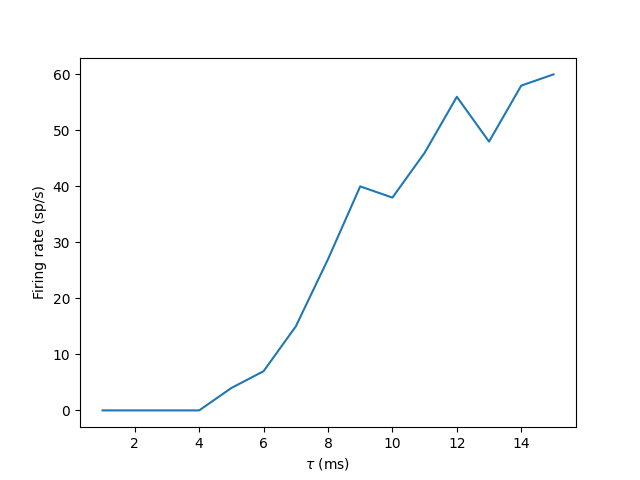Example: standalone_multiple_processes
This example shows how to run several, independent simulations in standalone mode using multiple processes to run the
simulations in parallel.
Given that this example only involves a single neuron, an alternative – and arguably more elegant – solution
would be to run the simulations in a single NeuronGroup, where each neuron receives input with a different rate.
The example is a standalone equivalent of the one presented in /tutorials/3-intro-to-brian-simulations.
Note that Python’s multiprocessing module cannot deal with user-defined functions (including TimedArray) and other
complex code structures. If you run into PicklingError or AttributeError exceptions, you might
have to use the pathos (https://pypi.org/project/pathos) package instead, which can handle more complex
code structures.
import numpy as np
import matplotlib.pyplot as plt
import brian2 as b2
from time import time
b2.set_device('cpp_standalone', build_on_run=False)
class SimWrapper:
def __init__(self):
self.net = b2.Network()
P = b2.PoissonGroup(num_inputs, rates=input_rate)
eqs = """
dv/dt = -v/tau : 1
tau : second (constant)
"""
G = b2.NeuronGroup(1, eqs, threshold='v>1', reset='v=0', method='euler', name='neuron')
S = b2.Synapses(P, G, on_pre='v += weight')
S.connect()
M = b2.SpikeMonitor(G, name='spike_monitor')
self.net.add([P, G, S, M])
self.net.run(1000 * b2.ms)
self.device = b2.get_device()
self.device.build(run=False, directory=None) # compile the code, but don't run it yet
def do_run(self, tau_i):
# Workaround to set the device globally in this context
from brian2.devices import device_module
device_module.active_device = self.device
result_dir = f'result_{tau_i}'
self.device.run(run_args={self.net['neuron'].tau: tau_i},
results_directory=result_dir)
return self.net["spike_monitor"].num_spikes/ b2.second
if __name__ == "__main__":
start_time = time()
num_inputs = 100
input_rate = 10 * b2.Hz
weight = 0.1
npoints = 15
tau_range = np.linspace(1, 15, npoints) * b2.ms
sim = SimWrapper()
from multiprocessing import Pool
with Pool(npoints) as pool:
output_rates = pool.map(sim.do_run, tau_range)
print(f"Done in {time() - start_time}")
plt.plot(tau_range/b2.ms, output_rates)
plt.xlabel(r"$\tau$ (ms)")
plt.ylabel("Firing rate (sp/s)")
plt.show()
